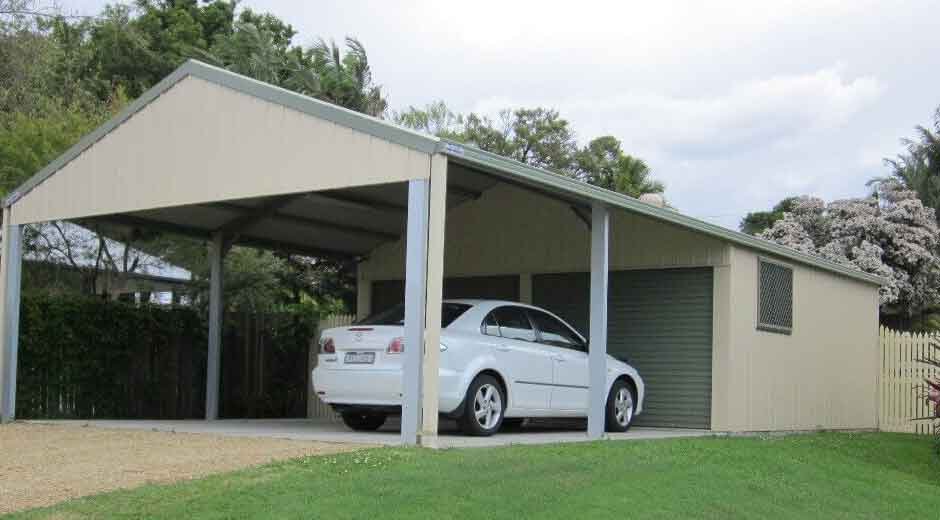Skip to the good bit
ToggleNot all shed kits are created equal, especially when it comes to turning one into a carport. It might seem like a simple solution, but there’s more to it than throwing up a few posts and a roof. A shed kit can be a great starting point, but only if it fits the job.
So, how do you pick the right one? What features actually matter? And what should you avoid?
What Makes a Good Shed Kit for a Carport?
Carports are exposed to the elements and need to withstand a lot more than the average garden shed. You’re protecting a vehicle, not just tools or odds and ends, so the stakes are higher. Good shed kits have to be durable, practical, and safe. Here’s what to focus on:
Material Quality
This is not the place to cut corners. A thin tin shed might keep garden gear dry for a while, but it won’t stand up to wind or sun long-term. For carports, go for materials that are strong and proven to last. Steel is a popular choice because it’s corrosion-resistant and structurally tough. Treated timber can also work if maintained properly, especially in settings where appearance matters. Aluminium is another option, particularly in coastal areas, though it tends to dent more easily.
Your choice should depend on the environment. Coastal zones need higher resistance to corrosion. Areas exposed to wind or storms will require extra reinforcement and anchoring.
Roof Style and Strength
The roof is the first line of defence. It needs to protect from rain, sun, and sometimes falling debris. Flat roofs may be easier to build, but they can struggle with water drainage. A gable or skillion roof is often better for carports, allowing better runoff and airflow.
Check the load rating too. In regions that experience heavy rainfall or hail, the roof must be built to take the pressure without sagging or leaking.
Open vs Enclosed
Not every shed kit is designed to be open on the sides, which is what most people want for a carport. Some kits are fully enclosed and will need modifying. That could mean cutting panels, removing parts, or changing the structure entirely.
It’s far easier to go with a design that’s already suited to an open-sided layout or has the flexibility to remove side walls without compromising stability.
Key Considerations Before You Buy
Before clicking buy on the first shed kit you find, take a moment to think through the specifics. Not just the size, but how it’s going to be used, where it’s going to go, and what local rules apply.
Your Purpose and Use
Think about what you’re covering. A single car for daily use has different needs than a large van, boat, or dual vehicle setup. You may also want additional space for storage, tools, or even future changes. A bit of extra clearance in height and width can go a long way. It’s better to oversize slightly than build something too tight.
Site Conditions
Flat, stable ground is essential. If your block is on a slope or has soft soil, you’ll need to factor in extra work. That could include levelling, reinforced footings, or heavier-duty anchors to keep things stable over time.
Also, look at how water flows through your site. Pooling water around the base can weaken materials and create long-term problems.
Wind and Weather Zones
Local councils often have regulations around wind ratings, especially in storm-prone or cyclone areas. Your kit has to meet the standards for your region. That means bracing, proper fixings, and sometimes engineering certification.
Even if your council doesn’t require a permit, it’s worth building to a higher spec. Better safe than dealing with twisted metal after a bad storm.
Council Approval and Permits
Every area is different. Some councils allow minor structures without approval, while others need full plans and inspections. Always check what rules apply to your property before building.
Don’t assume a shed kit can be used as a carport without changes. Some kits are designed for storage only and may not pass as structural support for a roof without modifications.
Common Mistakes to Avoid
It’s easy to get caught up in price or convenience, but those shortcuts can lead to regret. Watch for these red flags when picking a shed kit for a carport conversion.
- Going too small– Always allow for extra width and height. It’s better to oversize slightly than squeeze your car in.
- Ignoring anchoring– A structure that isn’t secured properly is a hazard, especially in bad weather.
- Underestimating local rules– Even if a structure looks temporary, your council might not see it that way.
- Choosing style over function– A sleek flat roof might look good, but if it leaks or doesn’t ventilate well, it’s a problem.
Think Long Term
A carport isn’t just a place to park. It protects your vehicle from sun damage, hail, bird mess, and debris. It can also boost property value and be used for more than just cars; think boats, bikes, tools, or even a shaded work area.
That’s why it’s worth taking the time to get it right. Don’t just go with the cheapest kit or the first one that pops up. Make sure it ticks every box.
- Strong, weatherproof materials– Not all kits are built for outdoor use year-round
- Roof design that suits your climate– Consider water drainage and airflow
- The right size for your needs– Plan ahead for all vehicle types and uses
- Complies with local building rules– Saves you headaches with permits and safety
It’s not just a shed anymore. It’s a permanent feature, and it needs to last.
Make the Right Call Before the Build Starts
Measure twice, read all the specs, check local requirements, and be sure the shed kit you’re considering can truly handle life as a carport.
Sometimes the best decision is to take a little longer to plan properly. A solid carport starts with the right foundation, and that begins before a single post goes up.







